
Lunenburg is a port town on the South Shore of Nova Scotia, Canada. Founded in 1753, the town was one of the first British attempts to settle Protestants in Nova Scotia.

The Canadian Coast Guard is the coast guard of Canada. Formed in 1962, the coast guard is tasked with marine search and rescue (SAR), communication, navigation, and transportation issues in Canadian waters, such as navigation aids and icebreaking, marine pollution response, and support for other Canadian government initiatives. The coast guard operates 119 vessels of varying sizes and 23 helicopters, along with a variety of smaller craft. The CCG is headquartered in Ottawa, Ontario, and is a special operating agency within Fisheries and Oceans Canada.

CCGS Louis S. St-Laurent is a Canadian Coast Guard (CCG) heavy icebreaker. Louis S. St-Laurent's home port is St. John's, Newfoundland and Labrador. It is the largest icebreaker and flagship of the CCG.
Marine Industries Limited (MIL) was a Canadian ship building, hydro-electric and rail car manufacturing company, in Sorel-Tracy, Quebec, with a shipyard located on the Richelieu river about 1 km from the St. Lawrence River. It employed up to 8,500 people during the World War II support effort.
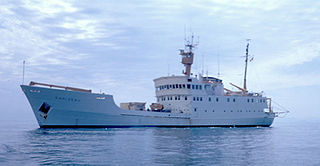
CCGS Parizeau was a Canadian Coast Guard research vessel that served from 1967 to 2001. Initially serving on the West Coast of Canada from 1967 to 1991, in 1992, the ship transferred to the East Coast of Canada. Taken out of service in 2004, the ship was later sold and converted to a yacht and unsuccessfully used for drug smuggling as Destiny Empress.
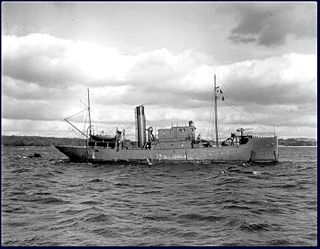
HMCS Arleux was one of twelve Battle-class naval trawlers used by the Royal Canadian Navy (RCN). Entering service in 1918 near the end of the First World War, the vessel had a short career with the RCN, being transferred to the Department of Marine and Fisheries in 1922. Arleux was used for fisheries patrol off the east coast of Canada until 1939, when the ship was reacquired by the RCN at the onset of the Second World War. Used as a gate vessel during the war and designated Gate Vessel 16, the ship was sold for mercantile purposes following the war. The ship foundered in 1948 off the coast of Nova Scotia.

HMCS Arras was one of twelve Battle-class naval trawlers that saw service with the Royal Canadian Navy (RCN). The vessel entered service in 1918 near the end of the First World War and was used for patrolling and escort duties along the Atlantic Coast of Canada. Following the war, Arras was transferred to the Department of Marine and Fisheries where the ship was used as a fisheries patrol vessel. Following the outbreak of the Second World War, the ship re-entered RCN service as a gate vessel. In 1943, the ship was heavily damaged by fire and was broken up in 1957.

HMCS St. Eloi was one of twelve Battle-class naval trawlers constructed for and used by the Royal Canadian Navy (RCN) during the First World War. Following the war the ship was transferred to the Canadian Department of Marine and Fisheries and converted into a lightvessel. Re-designated Lightship No. 20, the vessel returned to RCN service in 1940 to become the gate vessel Gate Vessel 12 during the Second World War. After the war, the trawler returned to government service and was discarded in 1962.

The Battle-class trawlers were a class of naval trawlers built for and used by the Royal Canadian Navy (RCN) during the First World War. Between the wars, some remained in RCN service, but most were transferred to the Department of Marine and Fisheries, where they performed a number of functions, including working as lightships and fisheries patrol vessels. During the Second World War, a number of these trawlers were re-acquired by the RCN, but all the navy's Battle-class trawlers were decommissioned soon after the war. A number of the class remained in civilian government and commercial service for years after the war, although most had been disposed of by the early 1960s.
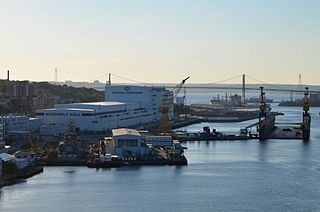
The Halifax Shipyard Limited is a Canadian shipbuilding company located in Halifax, Nova Scotia.
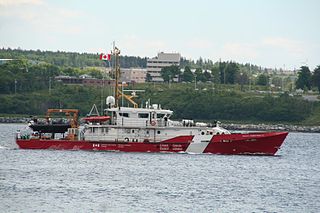
The Hero-class patrol vessels, previously the Mid-Shore Patrol Vessel Project, is a series of nine patrol vessels constructed by Halifax Shipyards for the Canadian Coast Guard. Based on the Dutch Damen Stan 4207 patrol vessel, construction began in 2011 and the first vessel entered service in 2012. The vessels are assigned to the Atlantic and Pacific coasts of Canada, used for coastal patrol duties.
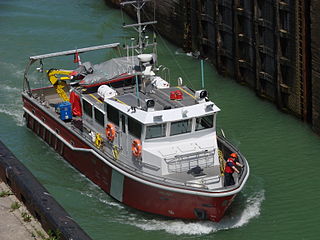
CCGS Kelso is a scientific research vessel operated by the Canadian Coast Guard from CGS Base Burlington in the Central and Arctic Region of Canada. She was commissioned on September 8, 2009, by Terence Young, Member of Parliament for Oakville, at the Canadian Centre of Inland Waters in Burlington. The vessel was built by ABCO Industries Lunenburg Shipyard to replace the retiring CCGS Shark. The ship is named for the late Dr John Kelso, a noted scientist with the Department of Fisheries and Oceans, the parent department for the Coast Guard.

Irving Shipbuilding Inc. is a Canadian shipbuilder and in-service support provider. The company owns industrial fabricators Woodside Industries in Dartmouth, Marine Fabricators in Dartmouth, Halifax Shipyard as the largest facility and company head office as well as Halifax-based Fleetway Inc., an engineering and design, support and project management firm.
Smith & Rhuland was a shipyard located in Lunenburg, Nova Scotia, Canada. The yard was originally opened in 1900 and was the builder of the esteemed Bluenose. The shipyard prided itself in creating quality vessels of all shapes and sizes.

Camp Norway was a Norwegian military training facility located in Lunenburg, Nova Scotia, Canada, during the Second World War.
HMCS Reo II was a former rum-running vessel turned military vessel from Meteghan, Nova Scotia. Built in 1931, the ship was used for rum running for five years until Prohibition ended, and was turned into a coastal freighter. She was commissioned during World War II by the Royal Canadian Navy as an auxiliary minesweeper. Declared surplus by the navy in 1945, she was sold to private interests in 1946. Reo II ended up in Lunenburg, Nova Scotia under the care of the Lunenburg Marine Museum Society. In 1984 Reo II was deemed unfit for repair, and was scuttled off Halifax, Nova Scotia in 1985.

CCGS Captain Goddard M.S.M. is one of the Canadian Coast Guard's nine Hero-class patrol vessels. The ship entered service in 2014 and is based at Victoria, British Columbia on Canada's West Coast. The vessel's primary roles will be fishery and environmental patrols, border control, search and rescue.

CCGS Corporal Teather, C.V. is the third of nine of the Canadian Coast Guard's Hero-class patrol vessel. Constructed in 2013, the ship entered service the same year. Corporal Teather C.V. is based in Dartmouth, Nova Scotia, tasked with fisheries patrol and enforcement.

CCGS Corporal McLaren M.M.V. is the sixth vessel of the Canadian Coast Guard's Hero-class patrol vessels. The ship entered service in 2013, tasked with enforcing Canadian maritime law within Canada's nautical borders. The ship was the subject of sabotage in 2018 and is under repair.















